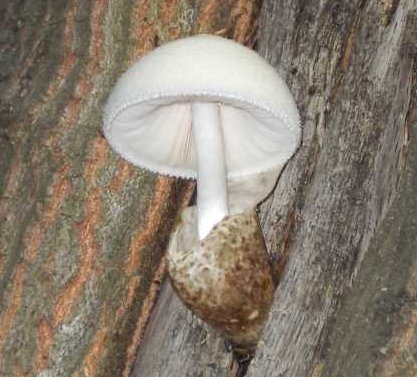Volvariella bombycina (Schaeff.) Singer, the silky rosegill.
Synonyms
Agaricus bombycinus Schaeff.
Fung. Bavar. Palat. 4: 42 (1774)
Volvaria bombycina (Pers.) P. Kumm.
Führ. Pilzk. (Zwickau): 99 (1871)
Common names
Silky rosegill
Silver-silk straw mushroom
Description
Cap: 5-20 cm in diameter, oval, becoming campanulate or convex and then nearly plane; surface dry and covered with long silky fibrils (usually more coarsely fibrillose at margin), white to yellowish (often palest at the margin).
Flesh: thin and soft or flaccid, white.
Gills: crowded, free, broad, white when young becoming flesh-colored or pinkish as the spores mature.
Stem: 6-20 cm long, 1-3 cm thick, usually tapered upward or enlarged below, often curved, smooth, white, firm.
Spore print: pinkish to deep flesh color.
Spores: 6.5-10 x 4.5-6.5 µm, elliptical, smooth.
Edibility: edible.
Habitat: grows on dead wood such as beech, elm, poplar and maple. It can also grow on injury sites on live wood. Rare.
Nutritional composition
One study investigated the possibility of using a food waste, soy milk residue, to serve as food source for Volvariella bombycina mycelia grown in liquid culture. Comparing the chemical composition of the mycelial biomass with fruiting bodies revealed that in terms of crude protein, lipid, ash and nucleic acid content, there is little difference between the mycelia and fruiting bodies. However, the total dietary fiber and amino acid composition varied greatly; lysine was the limiting amino acid found in all mushroom samples (Cheung, 1997).
Medicinal properties
Antioxidant activity
Both the culture liquid and the mycelial biomass of V. bombycina were shown to have good antioxidative activity, as measured by the ability to inhibit the free radical peroxidation of lipids in rat brain homogenate (Badalyan et al., 2003). Further study into various factors contributing to the antioxidant levels in this species have also been reported (Badalyan and Suzanna, 2003).
Polysaccharides extracted from the mycelial culture of V. bombycina and administered intraperitoneally into white mice at a dosage of 300 mg/kg inhibited the growth of Sarcoma 180 and Ehrlich solid cancers by 100% (Ohtsuka et al., 1973).

My name is Austin Collins.
I've dedicated my life to Mushrooms.
I believe Mushrooms are the best kept secret when it comes to health and well being.
For that reason, I would like to share a company with you that in my opinion makes the best mushroom products on the market.
The company is called Noomadic Herbals, my favorite supplement they make is called "Mushroom Total".
I take their products every day and they have helped me think better and have more energy. Give them a try.
-Austin
Links
Mushroom Expert
Fungi on Wood
There’s a nice photo gallery at Josef Hlasek’s site
References
Acosta-Urdapilleta L, Bautista N, Mora VM, Portugal D, Lopez L.
Cultivation in the laboratory and fructification of the edible fungus Volvariella bombycina var. flaviceps.
Cryptogamic Botany. 1993 2-3:257-9.
Badalyan CM, Gasparyan AV, Garibyan NG.
Investigation of the antioxidant activity of some basidial macromycetes.
Mikol Fitopatol. 2003 37(5):63-8. [Russian]
Badalyan, Suzanna M.
Edible and medicinal Higher Basidiomycetes mushrooms as a source of natural antioxidants.
Int J Med Mush. 2003 5(2):153-62.
Cheung PCK.
Chemical evaluation of some lesser known edible mushroom mycelia produced in submerged culture from soy milk waste
Food Chem. 1997 60(1):61-5.
Cho SM, Park JS, Kim, Yang-Sup; Chang KY, Kim KP, Yu SH.
Chemical properties and immunostimulating activity of polysaccharides from some edible mushrooms using various extraction methods.
Meeting Information: Annual Meeting of the Korean Society of Mycology.
Mycobiology. 2000 28(4):217.
Flegler SL.
A method for production of Volvariella bombycina fruit bodies in culture.
Mycologia.1981 73(5):992-3.
Ohtsuka S, Ueno S, Yoshikumi C, Hirose F, Ohmura Y, Wada T, Fujii T, Takahashi E.
Polysaccharides having an anticarcinogenic effect and a method of producing them from species of Basidiomycetes.
UK Patent 1331513, 26 September 1973.
Salmones D, Martinez-Carrera D, GuzmanN G.
A comparative study of the cultivation of Vovariella bakeri and Volvariella bombycina on various agricultural wastes.
Biotica (Mexico). 1988 13(1-2):7-16.





Hey hey mushroom guy I have a mushroom I am try to grow its called silky rosegill I have one cake and 5 spore print of it
Good luck!
Hows your attempt at growing going?